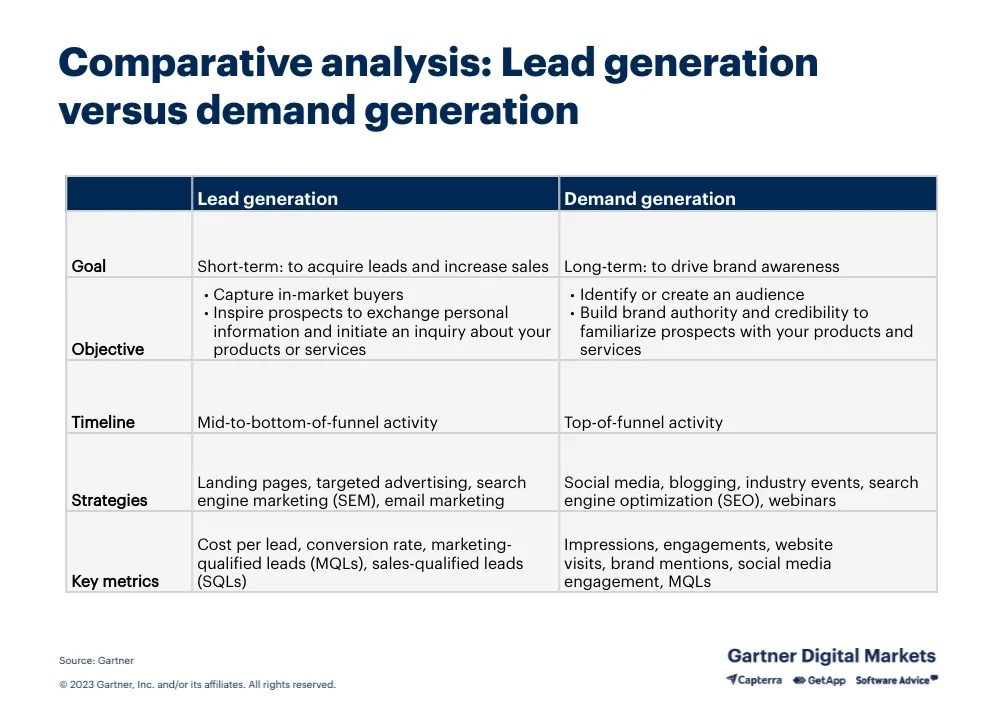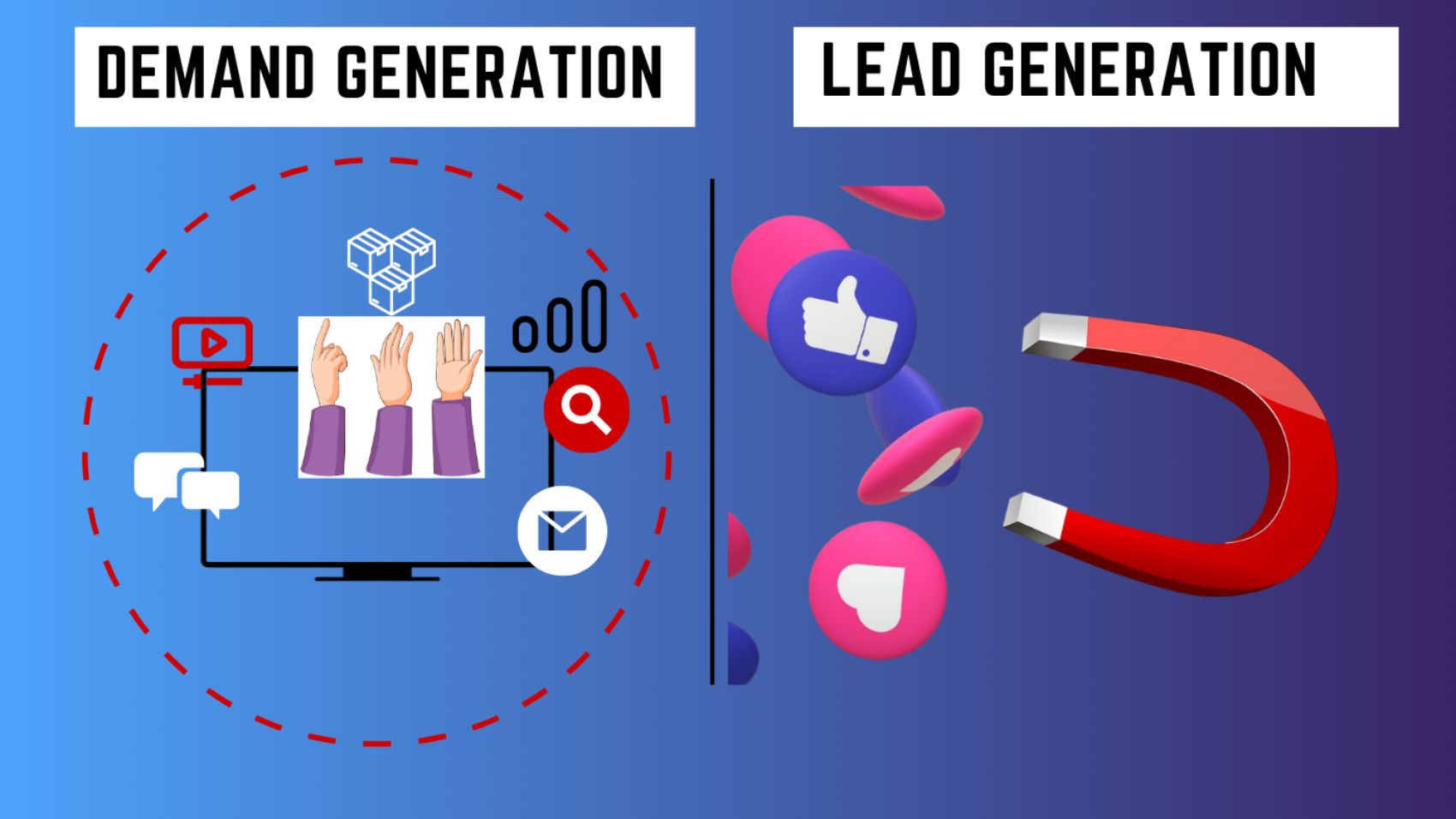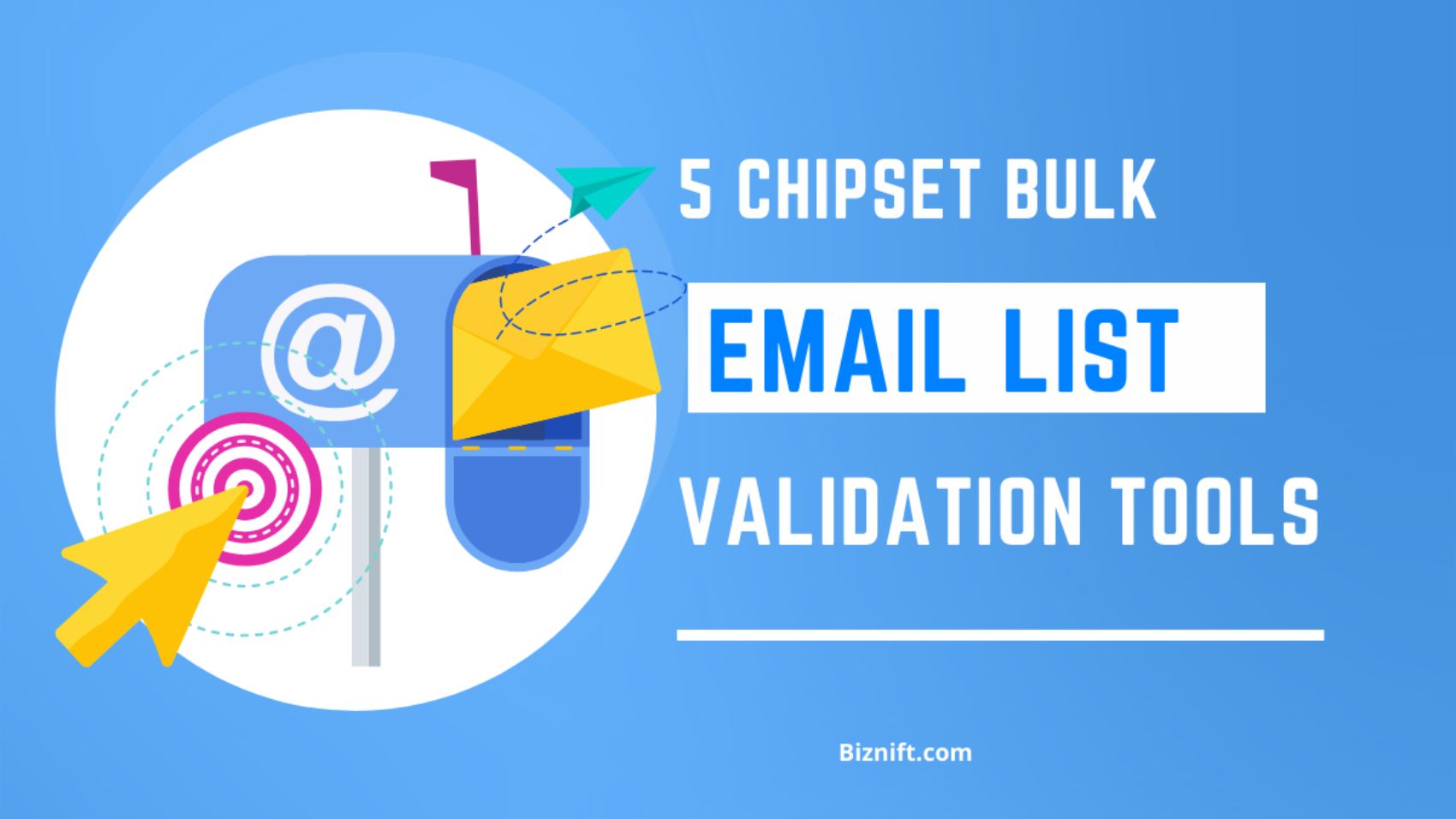Introduction
Demand generation and lead generation are two essential strategies in modern marketing. Demand generation focuses on creating awareness, interest, and desire for a brand or product category. On the other hand, lead generation aims to capture contact information from potential customers who are actively interested in your offerings. Both strategies play a crucial role in driving business growth and should be implemented together for optimal results.

Image Credit: emt.gartnerweb.com
Demand generation refers to the strategic marketing approach aimed at creating awareness, interest, and desire for a brand or product category. It focuses on generating demand among a broad audience by educating them about the problem the company addresses and building trust and credibility. Through various tactics such as content marketing, public relations, social media marketing, and industry events, demand generation aims to increase brand awareness and establish thought leadership in the industry.
Demand Generation: Elevating Brand Awareness
Demand generation is the strategic fuel that propels brand visibility and consumer interest. It’s the art of cultivating awareness, igniting curiosity, and nurturing desire among potential customers. In a crowded marketplace, where attention is scarce and choices abound, mastering demand generation is crucial for businesses to carve out their space and thrive.
Objectives Of Demand Generation:
- Amplify Brand Awareness and Thought Leadership: Demand generation efforts aim to elevate brand recognition and establish the company as a beacon of expertise in its field. By consistently delivering valuable insights and engaging content, businesses position themselves as trusted advisors, fostering loyalty and credibility among their audience.
- Educate and Empower Consumers: Effective demand generation involves more than just selling products; it’s about addressing the pain points and challenges faced by consumers. By educating the target audience about the problems their company solves, businesses empower consumers to make informed decisions, building trust and rapport along the way.
- Stoke Interest and Excitement: Through captivating storytelling and strategic messaging, demand generation campaigns aim to spark curiosity and excitement among potential customers. By showcasing the unique value proposition of their offerings, businesses capture attention, differentiate themselves from competitors, and inspire action.
- Establish Trust and Credibility: Trust is the currency of modern commerce, and demand generation initiatives are designed to earn it. By delivering consistent value, demonstrating expertise, and fostering authentic connections, businesses build trust and credibility with their audience, laying the groundwork for long-term relationships.
Tactics Of Demand Generation:
- Content Marketing (Blogs, Infographics, eBooks): Content is king in the realm of demand generation. By creating informative blog posts, visually compelling infographics, and comprehensive eBooks, businesses attract, educate, and engage potential customers, positioning themselves as authoritative sources within their industry.
- Public Relations and Media Outreach: Strategic media outreach is a cornerstone of effective demand generation. By securing coverage in relevant publications, leveraging influential partnerships, and amplifying their message through PR efforts, businesses increase visibility, credibility, and trust among their target audience.
- Social Media Engagement: Social media platforms provide a dynamic arena for building brand awareness and fostering meaningful connections. By sharing compelling content, engaging in authentic conversations, and nurturing relationships with followers, businesses cultivate a loyal community of brand advocates, driving traffic and conversions in the process.
- Industry Events and Networking: Participating in industry events and conferences is a powerful way to establish thought leadership and generate demand. By showcasing expertise, networking with peers and prospects, and staying abreast of industry trends, businesses elevate their brand profile and attract new opportunities.
In essence, demand generation is the engine that powers brand awareness, trust, and engagement. By deploying a strategic mix of tactics such as content marketing, public relations, social media engagement, and industry networking, businesses can effectively reach their target audience, differentiate themselves from competitors, and drive sustainable growth and success.
Lead Generation: Capturing Qualified Leads
Lead generation refers to the strategic marketing approach employed to capture potential customer information, such as email addresses or phone numbers, to nurture and convert them into paying customers. It focuses on identifying and attracting qualified leads who have shown active interest in a company’s products or services. Lead generation tactics include landing pages, email marketing campaigns, paid advertising, free trials, and demos.
Objectives Of Lead Generation:
1. Identify and Attract Potential Customers:
At the core of lead generation lies the goal of identifying and attracting individuals who have shown interest in the products or services offered by a business. Through targeted marketing efforts and strategic messaging, businesses aim to capture the attention of their ideal audience and compel them to take action, whether it’s signing up for a newsletter, downloading a resource, or requesting more information.
2. Qualify Leads and Prioritize Engagement:
Not all leads are created equal. One of the key objectives of lead generation is to qualify leads based on their level of interest, intent, and fit with the company’s target audience. By implementing lead scoring and segmentation strategies, businesses can prioritize engagement with high-quality leads who are more likely to convert into paying customers, thereby maximizing their marketing efforts and resources.
3. Nurture Relationships and Build Trust:
Lead generation isn’t just about acquiring new customers; it’s also about nurturing relationships and building trust over time. Through personalized communication, valuable content, and meaningful interactions, businesses aim to establish rapport with potential customers, positioning themselves as trusted advisors and partners in their journey towards solving their pain points and achieving their goals.
4. Drive Conversions and Revenue:
Ultimately, the primary objective of lead generation is to drive conversions and generate revenue for the business. By guiding leads through the sales funnel with targeted messaging, compelling offers, and persuasive calls-to-action, businesses aim to convert prospects into paying customers and, ideally, repeat buyers who contribute to the company’s bottom line and fuel its long-term growth.
5. Measure and Optimize Performance:
Continuous improvement is essential for success in lead generation. By tracking key metrics such as conversion rates, cost per lead, and customer lifetime value, businesses can gain valuable insights into the effectiveness of their lead generation efforts and identify areas for optimization and refinement. Whether it’s tweaking ad copy, testing different landing page designs, or adjusting targeting parameters, ongoing optimization is crucial for maximizing ROI and driving sustainable growth.
Lead Generation Tactics: Crafting the Path to Customer Acquisition
Lead generation requires a strategic blend of tactics to attract, engage, and convert potential customers into valuable leads. From content marketing to email campaigns, each tactic plays a crucial role in driving growth and revenue.
➤ Content Marketing:
Creating high-quality content is paramount for attracting and engaging potential leads. Blog posts, eBooks, and webinars serve as valuable resources that address the pain points of the target audience, establishing trust and authority in the process.
➤ Search Engine Optimization (SEO):
Optimizing content for relevant keywords enhances visibility on search engines, attracting organic traffic and generating leads. From on-page optimization to link building, a robust SEO strategy ensures that businesses rank prominently in search engine results pages (SERPs).
➤ Email Marketing:
Email remains a powerful tool for nurturing leads and guiding them through the sales funnel. Personalized emails and targeted drip campaigns keep prospects engaged and informed, ultimately driving conversions over time.
➤ Social Media Marketing:
Social media platforms provide opportunities for engaging with potential leads and driving traffic to the website. By sharing compelling content and participating in relevant conversations, businesses can expand their reach and generate leads on platforms like Facebook, Twitter, and LinkedIn.
➤ Paid Advertising:
Paid advertising offers a quick and effective way to reach a targeted audience and generate leads. From pay-per-click (PPC) ads to display ads and social media promotions, businesses can maximize their ROI by carefully targeting ads based on demographics and interests.
➤ Networking and Referrals:
Building relationships with industry peers and leveraging referrals can yield valuable leads. Attending networking events and incentivizing existing customers to refer new leads are effective tactics for expanding reach and building credibility within the industry.
Lead generation requires a strategic blend of tactics to attract, engage, and convert potential customers into valuable leads. From content marketing to email campaigns, each tactic plays a crucial role in driving growth and revenue.
Differentiators Between Demand Generation and Lead Generation
Feeling lost in the marketing jargon jungle? Don’t sweat it. Two terms that often cause confusion are demand generation and lead generation. Though similar, they play distinct roles in your customer acquisition journey. Grasping the difference is crucial for building a winning marketing strategy.
1. Seeding vs. Harvesting:
- Demand generation is like planting seeds. It focuses on raising awareness and interest in a broader audience. This involves creating educational content, building brand awareness, and sparking excitement through demos and free trials.
- Lead generation is like harvesting. It focuses on attracting and capturing contact information from those already interested in your offerings. This involves targeted landing pages, nurturing email campaigns, and strategic paid advertising.
2. Focus:
- Demand generation: Broader audience, cultivating a fertile ground for brand recognition and interest.
- Lead generation: Specific individuals actively interested in your products or services.
3. Goal:
- Demand generation: Cultivate brand awareness and desire in a broad audience.
- Lead generation: Convert website traffic into qualified leads ready for further nurturing and conversion.
4. Tactics:
- Demand generation: Content marketing, PR outreach, social media engagement, industry events.
- Lead generation: Landing pages, email marketing campaigns, paid advertising.
5. Synergy:
Demand and lead generation are not separate entities, but rather work together seamlessly. Demand generation primes the pump, while lead generation converts the interest into actionable leads. Mastering both creates a robust marketing funnel that attracts, nurtures, and converts potential customers into loyal brand advocates.
Also Read: 5 Chipset Bulk Email List Validation Tools of 2024
Conclusion:
In today’s marketing landscape, integrating demand and lead generation is essential. Demand generation builds awareness, while lead generation targets interested prospects. Together, they fuel business growth by creating a strong pipeline of qualified leads.
This combined approach optimizes results, capturing opportunities at every stage of the customer journey. It’s crucial for staying competitive and emerging as a leader in the industry.
In short, uniting demand and lead generation isn’t just strategic—it’s a game-changer. Embrace this synergy for unparalleled success in the ever-evolving marketing realm.


